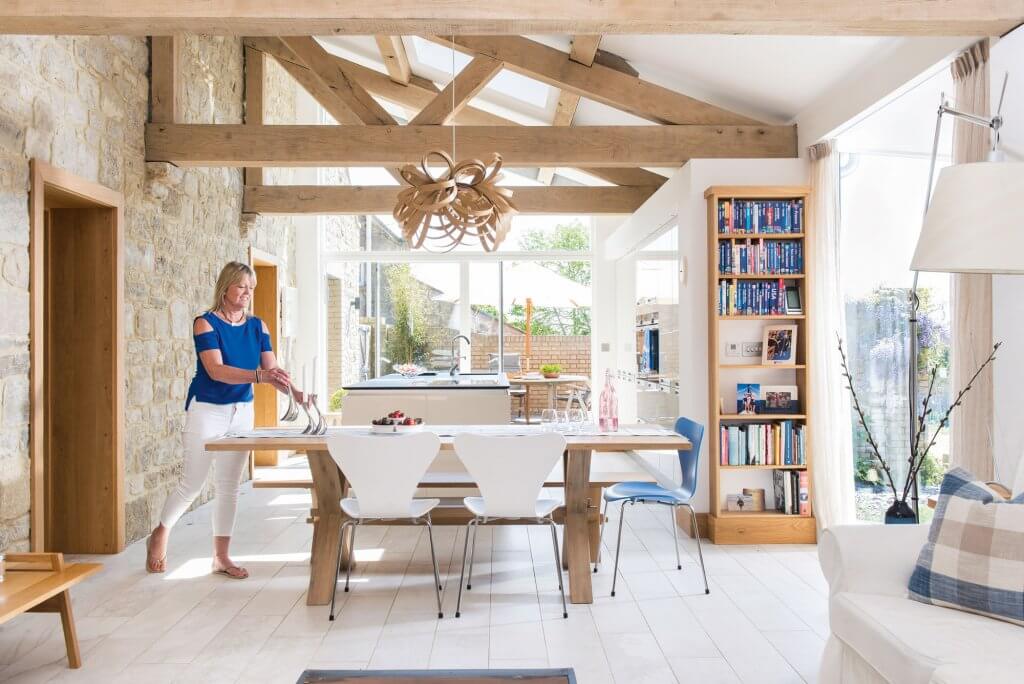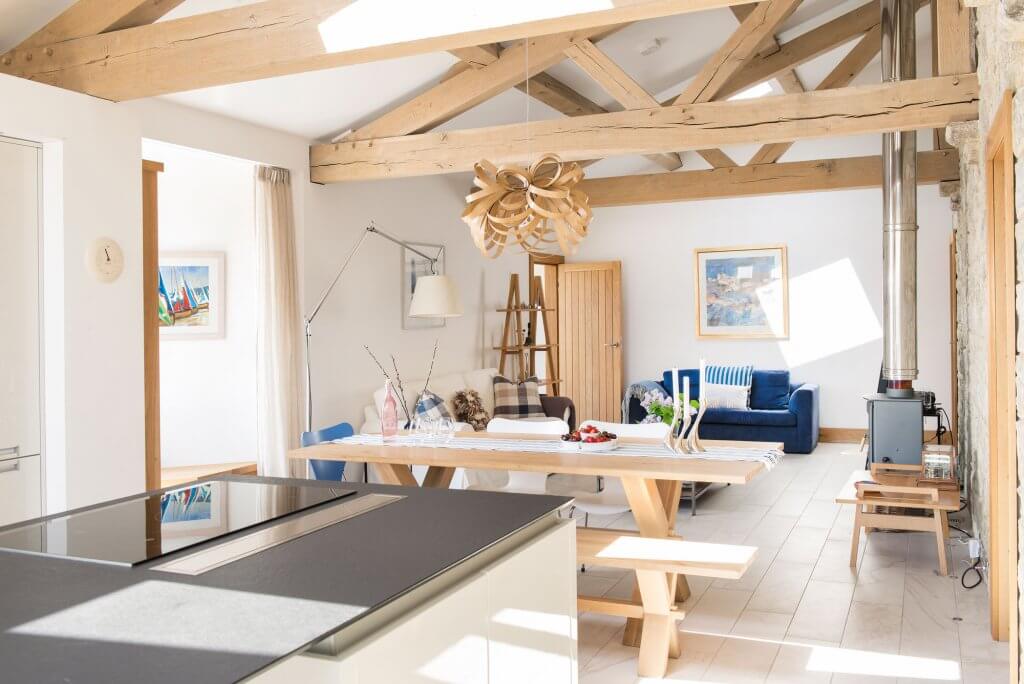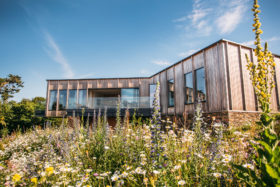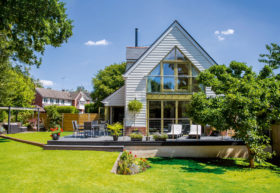

London-based architect Caroline Buckingham, a vice president of RIBA (The Royal Institute of British Architects), often sailed her yacht around the Isle of Wight. But it was only after taking to two wheels to explore the island on a bicycle that she made an unexpected discovery.
Turning down an unmarked track, she came across a dilapidated rendered cottage and cowshed with a for sale sign outside.
Ideas for a project immediately started to brew, and a short ride further along the beach confirmed that this was certainly somewhere with plenty of potential.
The unique setting of the site was a key draw. “I liked the farm next door, with its manor house and the lovely stone wall that encloses the orchard,” she says.
“It was the historical context, the backdrop and the community, too. You just get a gut feeling for the right spot, and I’d always wanted to be near the sea.”
As a 19-year-old architecture student, Caroline bought a property for £10,500 and used it to experiment with her ideas and DIY skills.
Thirteen homes later, having lived in a little green keeper’s cottage through to a Huf Haus that she commissioned, she still had a thirst to tackle a new project and felt this site was the ideal opportunity.
Caroline took her time to work out how to maximise the modestly sized plot. She’s a strong believer that in order to create an abode that fits with your lifestyle, you need to think about the way you live, how the property works and how people visit.
“Life changes, so you make your property future-proof and think of the long-term aspects; the building can evolve with you,” she says.
The architect ended up living in the run-down cottage for several years while deciding exactly what to do with it, staying in London during the week for work and travelling back to the Isle for weekends.
A cosy yet contemporary low-energy home with a sustainable design was in Caroline’s mind. She wanted to be involved in every aspect of the scheme, from the initial planning stages right through to the project management.
“I was keen to bring together everything I’d learnt and spend the necessary time to get the best possible quality of workmanship and detail,” she says. “I tested out a two-storey scheme with various different configurations. I had a card model and eventually settled on where I wanted to go with it.”
There were tweaks to make, however, and Caroline compromised when she realised that the two-storey element she’d planned meant her neighbour would lose his bedroom view of one of the Solent’s forts.
“I’m not a believer in keeping quiet. Consulting personally with the parish council and your neighbours is a good thing. They’re going to be told anyway,” she says.
“I redesigned this section so my neighbour retained his view, which in turn meant I got less space for my garage, utility and stairs. I could live with it.” She also spoke to the parish council and highways agency herself to gain their support.

Caroline’s neutral palette complements the pale green oak trusses, door linings and furniture. Hints of Scandi style include the pedant light by designer Tom Raffield
In terms of gaining consent, Caroline felt the experience was challenging – suggesting that planning departments are finding themselves increasingly under-resourced.
“On my previous projects, I’ve had a good dialogue with the planners – chatting and building a relationship,” she says. “This time round it felt more bureaucratic and less personal, with many more people involved in the consultation.”
It took a long time to secure approval, and Caroline’s still not sure why. “It was an existing property, so the precedent was set; it shouldn’t have taken so long,” she says.
Eventually, however, she was able to get a submission over the line. At this point, Caroline intended to retain the cottage as part of the new configuration. “We were already on site when we found it didn’t have foundations,” she says. “I knew I’d have to go back into planning for a rebuild, a different approval. I had people on site demolishing the house, so it was risky.”
The problems weren’t over. She budgeted for and designed the new foundations, but further digging revealed three redundant wells beneath the cottage floor, each 3m in diameter and 5m deep.
“When demolishing you make allowances but never actually know what’s
in the ground,” she says. “We compacted and filled them. It was like throwing wads of £50 notes into the holes; a real low point. It took a fair chunk of the budget.”
A large cast-iron boiler was also discovered beneath the cottage and had to be dug out. Thankfully, although the Isle of Wight is notorious for slipping ground, they found it to be good, making the rest of the work straightforward.
Caroline hired local Isle of Wight tradesmen, sourcing via word of mouth, viewing their past work and then selecting those with the best skills and an understanding of island traditions.
Her cousin, Donald McIntyre, had just completed his own self build and acted as her structural engineer. To cut waste on site, the stone from the original property was cleaned and reused. Unsuitable materials were crushed for aggregate and new ones sourced locally where possible.
She raised an initial build budget of £200,000 by selling a property and – with regret – her yacht, Cheeky Monkey. Caroline cut her London working week to four days and had a daily early morning catch-up with her builder Melvin Ansell, even for a period when she was working in the Middle East.
Being on site one day a week meant she was around to discuss problems, ideas and solutions. “Sometimes each trade wanted to be working at once,” she says.
“I had to think about sequencing; for instance, the joiner needing to wait for the electrician, or the plumber wanting to walk across the screed floor that had just been laid. Every project comes with relentless problem solving, but you forget it quickly, like childbirth.”

For the ground floor, Caroline chose Jumble porcelain tiles, supplied by Domus Tiles
Utility connections weren’t straightforward. The water main and electrics were simple enough, but getting gas caused complications.
All instructions were followed, with £3,000 paid upfront, but the pipe had to be relaid when Caroline was told that it wasn’t the right diameter.
“When you’re doing a professional job you take people at their word and I found it challenging when an anonymous organisation stepped in and we had to do it another way,” she says.
Money started to run out and the project wasn’t finished, meaning she needed time to get enough cash to build the studio and balcony.
“You don’t get Building Regs sign off until the work’s completed, so I had to wait,” says Caroline. “However long you think the build will take, my advice is that it’ll probably take at least half that time added on, or even double.”
Once these final works were done, the build cost tallied up to £22,000 over her intended budget.
Having lived in her highly energy efficient Huf Haus, Caroline was keen to make this home airtight, too.
She fitted higher levels of Kingspan insulation than required to ensure great thermal performance. Remote-controlled underfloor heating throughout keeps the temperature steady.
“I’m used to having radiators, switching them on and off, but once you’ve got an airtight structure and a balanced heating system in place, you shouldn’t need to fiddle with the control,” she says.
“The temperature remains constant using summer and winter modes.”
Final airtightness tests showed the house was close to the performance criteria of Passivhaus standards, and energy costs compare well with Caroline’s smaller London flat.
Making sure daylight was maximised was another important factor. “I used a 3D model to observe where the sun rises and how it moves across the building,” says Caroline.
Electrically controlled rooflights have been installed in the open-plan kitchen-living area, which she calls the barn. This room features wide spans of glazing; she chose Velfac composite timber and aluminium units because of the product’s high performance capabilities.
For Caroline, the barn is the best feature.
“It’s such a flexible space and it’s linked to the outside,” she says. “Everyone gathers in here; in fact, it hosted 25 adults and 14 children in one go for a work event quite comfortably, lots of whom were architects. There’s nothing worse for an architect than criticism from other professionals!”
Another favourite space is the first-floor studio. It’s the only upper storey section of the property and features a raised sleeping deck and ensuite, perfect for use as both a workspace and a fourth guest bedroom.
Caroline appreciates having a place to be quiet, whether she’s reading or simply admiring the view from the adjacent balcony.
Apart from gaining a new beautiful home by the sea, the most rewarding aspect of the project for Caroline was working with the specialist tradespeople and getting the opportunity to try out different methods and details.
She loved having the freedom to test her architectural ideas; it was her house, so she didn’t need to adhere to a client’s brief like she does at work.
Although it had to be sold to finance the build, Caroline’s beloved yacht has lived on through the design of the two-storey section that houses her studio.
Its contemporary stainless steel connections and tie rod trusses, as well as the marine-style stairway, all pay homage to Cheeky Monkey.
Another reference is the triangular bay/window seat in the kitchen-dining area. Here, a fully glazed side meets with a sloping roof to create an inspiring focal feature.
Not wanting to spoil the exterior aesthetic of this element with a drainpipe, she installed
a chain to channel rainwater down into stones at the base.
“In true Blue Peter-style, I used cornflake packets to build a prototype resembling a yacht’s anchor roller,” says Caroline. “The chain rolls over and down into the stones. It caused hysteria as the guys thought it wouldn’t work – but it did and they really liked it because it proves that doing something different can create something good.”
Caroline loved that this project gave her a chance to put her architectural skills to the test and to experience a self build first-hand.
“I’ve learned about a different side to building, the actual construction, sequencing and programming,” she says. “That’s been really helpful because I now understand my clients better.”

